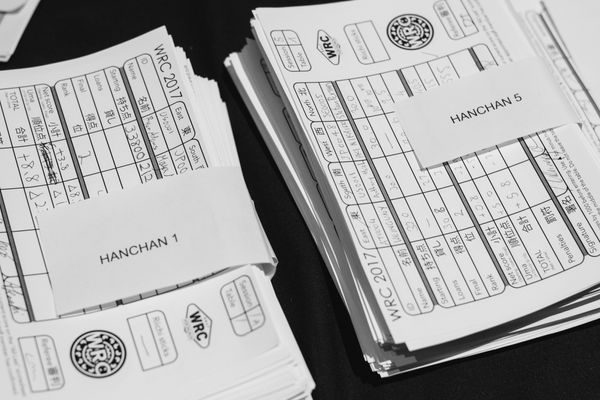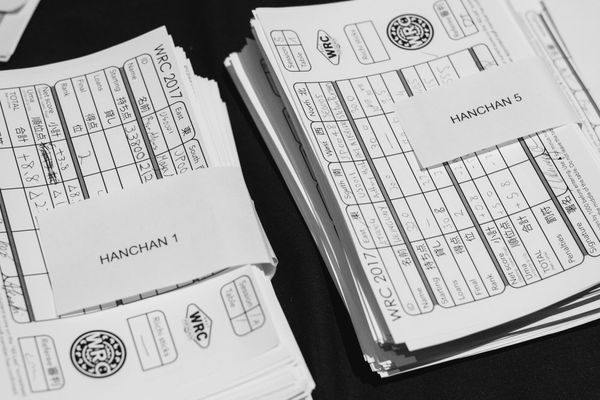UmaiKeiki's defense guide -- Betaori and Suji
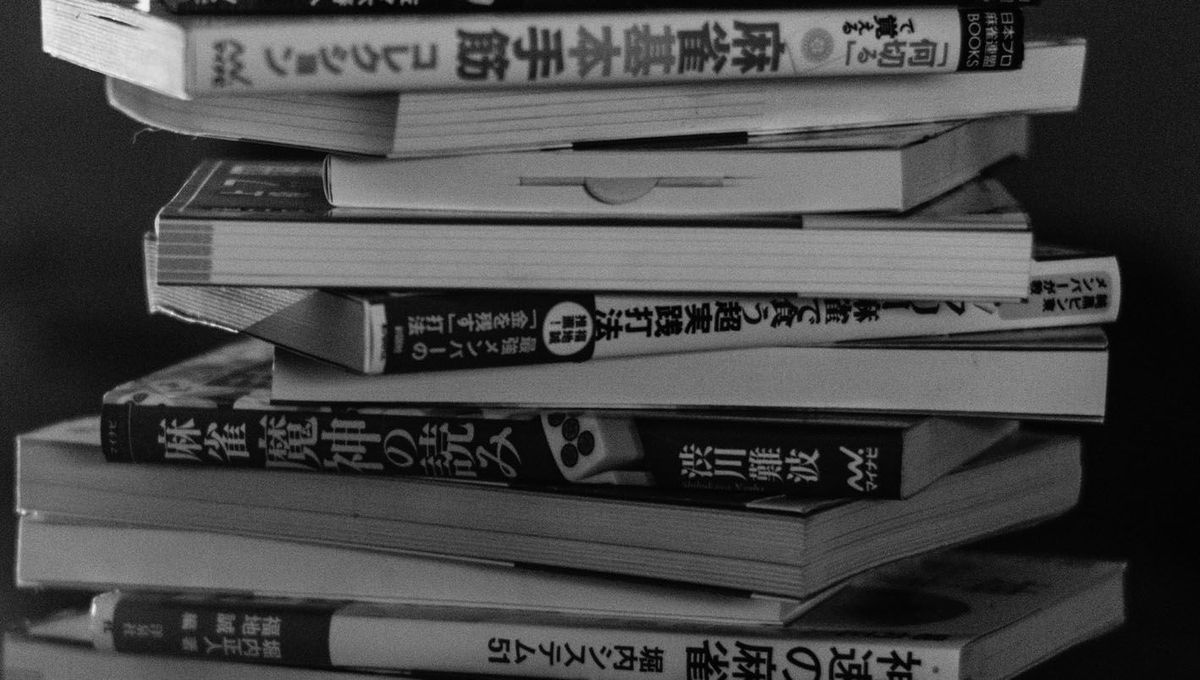
A guide to useful Riichi Mahjong strategy, such as discard reading and how to avoid dealing into hands.
What's up. This is UmaiKeiki, a Mahjong fan with a shorter attention span than that of a dog with ADD.
Some time ago I set out to write one of my Mahjong-addict buddies a guide to defense strategy. Once it was about half finished, something shiny caught my attention and the guide was long forgotten... One day Osamuko mentioned that she wanted to put something about Suji reading on here; I remembered that old guide and offered to revive it into blog form. This whole fetus is what I recovered off my old computer -- I make no guarantees that it doesn't suck horribly.
Brace for tl;dr!
Introduction to defense
Defense in Mahjong is focused primarily on how to avoid dealing into opponents' hands. In other words, playing defensively means making fewer payments. You know that saying "a penny saved is a penny earned"? This is VERY true in Japanese Mahjong! Your points are valuable; don't let someone take them without a fight!As with many gambling games, the good hands will come to you eventually; you must be patient and wait. Until then, it is only natural for some of the other players to reach Tenpai faster than you, and to win before you do. Don't sweat it! However, why should YOU be the one to deal into their hands? This can hurt your standing to the point where recovery is almost impossible, and it gives the other players a lead over you as well. Essentially, Japanese Mahjong seems to have become a game which is not about "winning more" but about "losing less". It is considered a wiser move to preserve the points you have rather than to risk them on the chance of getting some more. Therefore, the key to defense is to identify "safe tiles", which are tiles with a low probability of being an opponent's winning tile.
Fortunately there are a number of strategies that you can use to find safe tiles and identify which are more or less safe than others. The basics are Betaori, Suji, and Kabe. Against advanced players you may be interested in Damaten and Saki-giri. (I originally intended to include them all in this guide. Maybe there will be a "Part 2" in the future.)
Finally, a caution about discard reading. While it's most certainly possible to guess an opponent's waits and hand tiles, it's not an exact science. Because of this, it seems to be regarded as some kind of "black magic". Most people are afraid of it to some extent, so don't expect every discussion you have about discard reading to be entirely supportive of your ambitions.
Betaori
Betaori is the number one defensive strategy. Most people will use it as soon as someone declares Riichi, as it means that person is most likely to win this round. Don't worry about other people winning -- it happens. What you should be worried about is dealing into that person's hand and thus being the only one to lose points. To avoid this, you must often discard otherwise useful tiles from your hand and take apart mentsu.Ouch! Taking apart your hand? Some people hear this much and decide not to bother. I maintain that this is an important strategy and urge you to give it a try. Just watch what happens when someone declares Riichi. Chances are the others are going to start discarding tiles that very clearly indicate that they are in Betaori. So if anyone is going to deal into that Riichi, you're the most likely! And consider this: that opponent is Tenpai and could win at any second, but if you are still something like 2 Shan Ten, why would you keep attacking? It would take you much longer to catch up, and you would most likely have to discard some dangerous tiles to do so.
By the way, the No Ten payments are no excuse to avoid Betaori. If the round ends, you'll only be paying 1000, 1500, or 3000 points, and this is usually a lot better than dealing into someone's hand. (Anything with Riichi, specifically, will usually be worth more than 3000 points. USUALLY.) Besides, you should be able to make back those points in due time. Also, if you are playing "inflated" Mahjong, No Ten payments are really insignificant compared to the average winnings, so don't worry about it.
OK, so we know that we'll be breaking down the hand and trying to avoid a loss. How exactly do we do this? Well, the strategy goes like this:
-
Discard Furiten tiles
-
Discard into impossible waits
-
Discard into improbable waits
-
Discard into improbable yaku
-
Break apart An Kous etc.... and cross your fingers.
Step 1: Furiten tiles
At any given point in time, there is one 100% safe tile. This is the tile just discarded by your Kami Cha, aka the player to your left. At that moment, all 3 opponents are Furiten for that tile at the same time. So if you have the same tile in your hand, go ahead and discard it now because nobody can Ron it.On a similar note, if all 3 opponents have discarded the same tile at some point in the game, they are all Furiten for that tile. So if you have the fourth one, it also is a 100% safe tile. The difference here is that this one stays safe; the Kami Cha's discard is only safe for the current turn. Since some opponents will no longer be Furiten for the Kami Cha discard next turn, discard that one first!
Since you'll be using Betaori mainly against an opponent who has declared Riichi, you can focus on discarding that person's Furiten tiles. Just take a look at their discard history: they are Furiten for everything they've discarded so far. Also, you can use tiles that others have discarded since the Riichi was declared. Depending on the strictness of your house's Furiten rule, the others' discards may be safe for only one turn. However, if the person who declared Riichi didn't call them the first time, you can reasonably expect them to still be safe. (The only reason they would become dangerous again is that it wasn't considered advantageous to Ron off that specific opponent, so the person who could have won decided instead to become temporarily Furiten and wait for that tile to come from someone else.)
Now don't get ahead of yourself! Furiten tiles are the safest tiles you can deal. So if you are facing someone who has declared Riichi, discard their Furiten tiles before anything else. The key here is STALLING. Discarding a Furiten tile buys you one more round; for each round you stall, they could get their winning tile from someone else, meaning that you successfully dodged making the payment! Also, since more Furiten tiles can appear during each round, defending will become easier for each round you stall.
Step 2: Impossible waits
Impossible waits are somewhat rare, but keep an eye on the discards and you might find some. Jihai are common candidates for impossible waits: since they can't be used in shuntsu, the only possible waits are Shanpon and Tanki. (Kokushi Musou is an exception, but it should be easy to tell whether it is a threat.)Suppose you have a Chun in your hand, and you can see the other three Chun have been discarded already. That means nobody can have a shanpon or tanki wait on Chun, so it is an impossible wait. This also works if you have 2 Chun and the other 2 are discarded, or if you have 3 and one is the Dora indicator, or really any situation in which all 4 are visible.
Now finding impossible waits on number tiles is a bit harder, since you need to block any possible Shuntsu. Let's suppose all four of the  and
and  are visible. That means none of your opponents can have a shuntsu containing either
are visible. That means none of your opponents can have a shuntsu containing either  or
or  , so the only waits possible on
, so the only waits possible on  and
and  are Tanki and Shanpon. So if you have the last
are Tanki and Shanpon. So if you have the last  or the last
or the last  , they are 100% safe.
, they are 100% safe.
Step 3: Improbable waits
OK, we know that Furiten and impossible waits give us safe tiles, but what happens when we run out of safe tiles? We have to start discarding "mostly safe" tiles, which means that it is POSSIBLE for an opponent to be waiting on them, but it is not PROBABLE.Let's assume your opponents are fairly intelligent. They probably know a lot of attacking strategy. What kind of wait do you think they'll use? Ryanmen? You bet! Since Ryanmen is considered the "best" wait, you'll naturally see opponents using it most of the time. The less efficient the wait, the less likely someone is to Riichi on it. So if you are trying to avoid dealing into a Riichi, look for tiles that could only be used in "bad" wait types like Tanki, and work your way up. The goal is to just avoid dealing any tiles that could be used in Ryanmen waits.
The strategy for Tanki and Shanpon waits is pretty much the same as for impossible waits as described above. Let's go back to the Chun example. Suppose you have one Chun in your hand, and none are visible in discards. Then it's a "live" tile, and thus very dangerous. Now what if there were one Chun visible in discards? Then the efficiency of a Shanpon wait on Chun is reduced, but someone might still go for it just because they want to get that extra Han. What if 2 were visible? Then Shanpon is impossible; the only wait is Tanki. That makes it a lot safer; the only time you should worry about dealing it is when it's the Dora.
After we run out of Tanki and Shanpon waits, let's look for number tiles that could deal into Kanchan and Penchan waits, but still avoid Ryanmen. To do this, we'll need to "block off" any Ryanmen waits.
Let's suppose that all four of the  are visible. That means there can be no Ryanmen waits on
are visible. That means there can be no Ryanmen waits on  and
and  . (Note however that someone might be waiting on
. (Note however that someone might be waiting on  , as it would still count as Ryanmen.) The only possible waits on
, as it would still count as Ryanmen.) The only possible waits on  are Tanki, Shanpon, and Kanchan; the waits on
are Tanki, Shanpon, and Kanchan; the waits on  are Tanki, Shanpon, and Penchan. If you have one of those tiles in your hand and at least two are visible on the table, Shanpon is no longer possible. And if 3 were visible and you had the last one, Tanki is impossible and the only possible wait would be Kanchan/Penchan.
are Tanki, Shanpon, and Penchan. If you have one of those tiles in your hand and at least two are visible on the table, Shanpon is no longer possible. And if 3 were visible and you had the last one, Tanki is impossible and the only possible wait would be Kanchan/Penchan.
We can also use Suji to identify which Ryanmen waits are more dangerous than others. To cite the classic example, suppose your opponent is Furiten for  . That means
. That means 
 and
and 
 Ryanmen waits are less probable, since your opponent is already Furiten for one side. In this case, the
Ryanmen waits are less probable, since your opponent is already Furiten for one side. In this case, the  is safer because the only waits left are Shanpon and Tanki. The
is safer because the only waits left are Shanpon and Tanki. The  could be used in Shanpon, Tanki, Kanchan, and Penchan.
could be used in Shanpon, Tanki, Kanchan, and Penchan.
While Ryanmen is the main threat, do be aware that Kanchan and Penchan are somewhat dangerous. Sometimes people will use Kanchan waits as a really sneaky way of getting someone to throw them the Dora. And Penchan might be used in the interest of speed. To see how that works, put yourself in their shoes: suppose you are the first one to reach Tenpai, but you have an "inefficient" wait. You probably won't declare Riichi just yet, because you are more likely to draw a tile that will upgrade it to a better wait than you are to draw the winning tile. So you'll hold off until a better wait forms and then you'll Riichi. The exception would be if your wait were Penchan. Penchan waits are really hard to upgrade; you are more likely to draw the winning tile than you are to upgrade the wait. That means if you decide to upgrade, you'll be giving the opponents plenty of time to advance their hands and catch up. You'll probably try to Riichi now while they are weak, because it will force more of them to defend. Because of this, expect Penchan Riichis to be more frequent in early game than in late game.
Step 4: Improbable yaku
When you reach the point where anything you can discard would deal into a dangerous wait, it's time to choose tiles that ruin the opponent's chances of getting extra Han. You can still get hit by Ron, but at least the payments will be smaller.For example, if you think the opponent might be aiming for Tanyao, deal 1's and 9's. There is always a chance that the opponent has 
 waiting for
waiting for  or
or  , but if they really did have Tanyao, the payment you make for dealing
, but if they really did have Tanyao, the payment you make for dealing  is less than what you would pay for dealing
is less than what you would pay for dealing  .
.
And if you think they might be aiming for Chanta, start by dealing 5's, then 4's and 6's. Again, there is always a chance that the opponent has 
 waiting for
waiting for  or
or  , but if they really did have Chanta, the payment you make for dealing
, but if they really did have Chanta, the payment you make for dealing  is less than what you would pay for dealing
is less than what you would pay for dealing  .
.
If you suspect they might be aiming for Hon Itsu, just discard some tiles from a suit they probably don't have. Sometimes it won't be a Hon Itsu, but the majority of tiles will be in one suit. In that case, you can sometimes use their early number tile discards to find out what suits are safe.
Maybe your opponent built a wait around the Dora? Don't deal any tiles that are close to the Dora! Also, don't deal any red 5's until you see the nonred 5 pass.
Step 5: Break apart An Kous, etc.
This is something of a "last resort" strategy. If you have two, three, or maybe even all four instances of a tile in your hand, try discarding one. It's still dangerous, BUT if it passes, you know the rest are safe! Then you can just discard one each turn until you run out. The more instances of a tile you have, the longer you can stall, meaning some more Furiten tiles or other safe tiles are likely to come out.Another good move might be to discard tiles such that there are already several instances of that tile visible on the table. Your opponents might not Riichi if they know most of their waiting tiles are accounted for.
Suji
Suji is one of the more complex theories in Mahjong. There are many variations and types of Suji, but it all boils down to one basic goal: to identify which Ryanmen waits are safe and which are dangerous.Ordinary Suji are the tiles that complete Ryanmen waits. So for example...
If you have 
 in your hand, then the Suji are
in your hand, then the Suji are 
 .
.
If you have 
 in your hand, then the Suji are
in your hand, then the Suji are 
 .
.
In total, there are six Suji: 14, 25, 36, 47, 58, and 69. Multiply this by three suits, and there are 18 Ryanmen waits in all. Now we already know that most people who Riichi are going to use a Ryanmen wait. If there are only 18 possible waits they could have, wouldn't it be great if we could determine which are safe and which are dangerous? This is where Suji theories come in!
A common practice is to arrange the Suji into three groups, as follows:
Group 1: 


Group 2: 


Group 3: 


(Note -- I originally started rambling about "equivalence classes modulo 3" here, but I have decided to remove all the mathematical stuff from this post for sanity reasons.)
Every Shuntsu must contain one element from each group. Similarly, every Ryanmen wait is completed by two tiles from the same group. Now let's start with the most common Suji reading technique:
Omote-suji
(Or: "That 147 trick everyone already knows")Omote-suji is a rather basic discard reading technique; since it's somewhat intuitive, I expect a lot of players will have independently derived the underlying strategy before they even find out it has a name. Don't underestimate its power, though. It's great for identifying safe tiles during Betaori!
Suppose someone who has declared Riichi discards a  . Since they are now Furiten for that tile, you can reasonably assume they are not using a
. Since they are now Furiten for that tile, you can reasonably assume they are not using a 
 or
or 
 Ryanmen wait. This means that the Omote-suji,
Ryanmen wait. This means that the Omote-suji,  and
and  , are safe!
, are safe!
Remember, this scales across 147, 258, and 369. So if they discard a 5, then the Omote-suji (safe tiles) are 2 and 8. And if they discard a 6, then the Omote-suji are 3 and 9.
Depending on the strictness of your house's Furiten rule, this might be a little less reliable for tiles discarded early in the game. For example, if you discard a 6 early in the game but wind up with a 36 wait later, you can still Ron the 3 (but not the 6) under some rulesets. However, I don't expect this to happen very often, so we can assume Omote-suji applies to the opponent's entire discard history.
Don't forget that this applies to other players' discards as well! So if there is one person who declares Riichi, and someone ELSE discards a 5, then you can now safely discard the Omote-suji (2 and 8). And if you ever run out of safe tiles and throw a 4, 5, or 6 at random, then you just bought yourself two Omote-suji (assuming it passed).
Let's return to the 147 example for a minute. The opponent discards a 4; 1 and 7 are now safe. However, they are not EQUALLY safe! Remember, we can't guarantee the opponent is using a Ryanmen wait. Thus, if we are going to take into consideration the risk of other wait types, we should discard the 1 first because there are fewer wait types that it could complete.
When there are multiple Omote-suji, this list shows what waits are less dangerous:
 through
through  = Safe. No Ryanmen waits are possible, but they can still complete Penchan, Kanchan, Shanpon, and Tanki waits.
= Safe. No Ryanmen waits are possible, but they can still complete Penchan, Kanchan, Shanpon, and Tanki waits.
 or
or  = Safer. Only waits are Kanchan, Shanpon, and Tanki.
= Safer. Only waits are Kanchan, Shanpon, and Tanki.
 or
or  = Safest. Only waits are Shanpon and Tanki.
= Safest. Only waits are Shanpon and Tanki.
You might have noticed that Omote-suji are really only useful when people discard 4, 5, or 6. Let's suppose someone discards a  . This means that there is no
. This means that there is no 
 wait. Does this mean
wait. Does this mean  is safe? No -- they could still have a
is safe? No -- they could still have a 
 wait.
wait.
When someone discards an "outside" tile, in this case a  , the remaining
, the remaining 
 wait is called To'oi-suji. These are pretty useless; you can't discard the
wait is called To'oi-suji. These are pretty useless; you can't discard the  because it's still dangerous. However, if it's a toss-up between discarding
because it's still dangerous. However, if it's a toss-up between discarding  or
or  , for example, then
, for example, then  is slightly safer because it completes fewer waits.
is slightly safer because it completes fewer waits.
Now let's suppose both  and
and  have been discarded. THEN it's safe to deal the
have been discarded. THEN it's safe to deal the  , because both
, because both 
 and
and 
 waits are impossible.
waits are impossible.
OK, now that's out of the way, so let's turn our attention to types of Suji that indicate DANGEROUS waits. These are a lot more fun, simply because every once in a while they'll predict the exact wait an opponent is using, and it's awesome when they reveal their tiles and your prediction was correct!
Senki-suji
Senki-suji usually show up in early game discards of number tiles. They indicate a potentially dangerous wait two counts higher (or lower). Here is how it works:Let's say that at the start of the round, your only Man tiles are 
 . Recall that two tiles from the same Suji group can't form a Shuntsu, so this is a somewhat useless combination. Now let's assume the next tile you draw is either
. Recall that two tiles from the same Suji group can't form a Shuntsu, so this is a somewhat useless combination. Now let's assume the next tile you draw is either  or
or  . Let's look at the two situations this gives us:
. Let's look at the two situations this gives us:
Case 1: 

 . Now we have something useful. With this pattern early in the game, we could wind up with a really nice wait later, so we are probably not going to discard any of these tiles right away. That 7 probably won't come out until we are somewhat closer to Tenpai.
. Now we have something useful. With this pattern early in the game, we could wind up with a really nice wait later, so we are probably not going to discard any of these tiles right away. That 7 probably won't come out until we are somewhat closer to Tenpai.
Case 2: 

 . In this situation, we do have a Ryanmen wait shape, but that 7 still isn't helping. In all likelihood, that 7 will come out within the first few turns.
. In this situation, we do have a Ryanmen wait shape, but that 7 still isn't helping. In all likelihood, that 7 will come out within the first few turns.
What does this tell opponents? An early discarded 7 is likely to be a Senki-suji, indicating a possible dangerous wait 2 counts away. In this case, 7 - 2 = 5, so it would be understood that 
 is a dangerous wait.
is a dangerous wait.
Here is a list of all the Senki-suji. Note that there is no Senki-suji for 5. An early discarded 5 is more likely to be an Ura-suji, or possibly an indication of Hon Itsu.
| Discarded tile | Senki-suji |
|---|---|
 |
  |
 |
  |
 |
  |
 |
  |
 |
  |
 |
  |
 |
  |
 |
  |
Ura-suji
Ura-suji can show up at any time, but they are most frequent in midgame. They represent a Kanchan wait upgrading to Ryanmen. This means the discarded tile lies just outside of a dangerous wait, one count higher (or lower). To illustrate, let's use an example Tenpai hand. We can Riichi here, but what tile should we discard?













In this case, it's a matter of choosing between a 
 Ryanmen or a
Ryanmen or a 
 Kanchan wait. We know that a Ryanmen is better, so we'll probably discard the
Kanchan wait. We know that a Ryanmen is better, so we'll probably discard the  and Riichi.
and Riichi.
What does this tell opponents? That 9 is likely to be an Ura-suji, lying outside a dangerous wait one count away. In this case, 9 - 1 = 8, so it would be understood that 
 is a dangerous wait.
is a dangerous wait.
Here is a list of the dangerous waits indicated by Ura-suji. Watch out for TWO Ryanmen waits that can be used when a 5 is discarded.
| Discarded tile | Ura-suji |
|---|---|
 |
  |
 |
  |
 |
  |
 |
  |
 |
  and and   |
 |
  |
 |
  |
 |
  |
 |
  |
Matagi-suji
Matagi-suji are almost exclusive to late game discards. They indicate a Toitsu being broken down to take a Ryanmen shape. This means that the discarded tile lies between the two ends of a dangerous wait (and there are often two possible waits that enclose it). Again, here's an example to illustrate how it works. We can Riichi with this hand, but which tile should we discard?













The most efficient move would be to discard a  . What would this tell opponents? Since it was kept until late game, it may be a Matagi-suji, which lies between the two ends of a Ryanmen wait. The two Ryanmen waits that enclose
. What would this tell opponents? Since it was kept until late game, it may be a Matagi-suji, which lies between the two ends of a Ryanmen wait. The two Ryanmen waits that enclose  are
are 
 and
and 
 . Therefore, it would be understood that one of those two waits is dangerous.
. Therefore, it would be understood that one of those two waits is dangerous.
This concept of Matagi-suji is based on the versatility of a shape like 

 . Someone playing by the most efficient strategy possible will be trying to form Mentsu and will worry about pairs later. This is where a
. Someone playing by the most efficient strategy possible will be trying to form Mentsu and will worry about pairs later. This is where a 

 shape is so useful: it can be broken down at any time to get either a Toitsu OR a Ryanmen shape. So it will most likely be saved until late game when another Toitsu has appeared and the Ryanmen shape is now needed.
shape is so useful: it can be broken down at any time to get either a Toitsu OR a Ryanmen shape. So it will most likely be saved until late game when another Toitsu has appeared and the Ryanmen shape is now needed.
Because of this, you'll rarely see Matagi-suji in early game. Take advantage of this! If you see an early  discard, you can be almost certain that it didn't come from a
discard, you can be almost certain that it didn't come from a 

 shape. This means
shape. This means  is likely to be a safe tile later!
is likely to be a safe tile later!
Here is a list of dangerous waits indicated by Matagi-suji. Note that the 1 and 9 won't form Matagi-suji, so watch out for Ura-suji instead.
| Discarded tile | Matagi-suji |
|---|---|
 |
  |
 |
  and and   |
 |
  and and   |
 |
  and and   |
 |
  and and   |
 |
  and and   |
 |
  |
Think about this for a second: when an opponent discards a  , what's dangerous? If we consider the various Suji theories presented here, we might guess the dangerous waits are the Senki-suji
, what's dangerous? If we consider the various Suji theories presented here, we might guess the dangerous waits are the Senki-suji 
 , the Ura-suji
, the Ura-suji 
 , and the Matagi-suji
, and the Matagi-suji 
 and
and 
 . In fact, the only safe tiles left are the Omote-suji,
. In fact, the only safe tiles left are the Omote-suji,  and
and  Just knowing what all the Suji are is only the first step. We must be able to identify which Suji types are most likely to be indicated by each discarded tile. From here on, let's focus on strategies that narrow down the options for dangerous waits.
Just knowing what all the Suji are is only the first step. We must be able to identify which Suji types are most likely to be indicated by each discarded tile. From here on, let's focus on strategies that narrow down the options for dangerous waits.
Aida yon ken
Aida Yon Ken is a discard pattern in which a four-count interval is enclosed between two number tile discards. For example, discarding  and
and  forms an Aida Yon Ken; the interval between the two discards is
forms an Aida Yon Ken; the interval between the two discards is 


 .
.
What do  and
and  have in common? They're both Ura-suji for the same wait,
have in common? They're both Ura-suji for the same wait, 
 ! So whenever you see an Aida Yon Ken, watch out for a dangerous wait sandwiched between the two discarded tiles. Aida Yon Ken generally suggest that the two innermost tiles (in this case,
! So whenever you see an Aida Yon Ken, watch out for a dangerous wait sandwiched between the two discarded tiles. Aida Yon Ken generally suggest that the two innermost tiles (in this case, 
 ) are concealed in the hand, and the two outermost tiles (in this case,
) are concealed in the hand, and the two outermost tiles (in this case, 
 ) are the resulting wait.
) are the resulting wait.
Here is the list of Aida Yon Ken and the dangerous waits they box in:
| Discarded tiles | Aida yon ken |
|---|---|
  |
  |
  |
  |
  |
  |
  |
  |
Multiple Suji
A good way to identify which waits are more dangerous is to watch for multiple types of Suji for that wait. To get an idea of just how much information you are telegraphing through your discards, let's return to the age-old question, "What would you discard?"













With this hand, we are 1 Shan Ten, and the most efficient discard would be  . If we discarded it, we could reach Tenpai with any of
. If we discarded it, we could reach Tenpai with any of 




 ; in total 6 tiles, 20 instances. Now suppose we get lucky and draw
; in total 6 tiles, 20 instances. Now suppose we get lucky and draw  . What should we discard now?
. What should we discard now?














The most efficient discard is  , as it would leave us with a Ryanmen wait. Now when the opponents look at our discards, they'll see a
, as it would leave us with a Ryanmen wait. Now when the opponents look at our discards, they'll see a 
 pattern and will probably be able to recreate what was in our hand without much trouble. The
pattern and will probably be able to recreate what was in our hand without much trouble. The  is an Ura-suji for a
is an Ura-suji for a 
 wait, and the
wait, and the  is a Matagi-suji for the same wait! Someone who is playing by the most efficient strategy possible will discard Ura-suji first, then Matagi-suji later. Therefore, it won't be too hard for opponents to guess that we were discarding out of a
is a Matagi-suji for the same wait! Someone who is playing by the most efficient strategy possible will discard Ura-suji first, then Matagi-suji later. Therefore, it won't be too hard for opponents to guess that we were discarding out of a 


 shape and the
shape and the 
 wait is dangerous!
wait is dangerous!
So when you see multiple types of Suji for the same wait, you can be extra sure that wait is dangerous. Watch for Senki-suji to come out first, then Ura, then Matagi. Here are the six Ryanmen waits and the Suji that make them dangerous:
| Ryanmen wait | Suji discard order |
|---|---|
  |
 -- --  -- --   |
  |
 -- --   -- --   |
  |
  -- --   -- --   |
  |
  -- --   -- --   |
  |
 -- --   -- --   |
  |
 -- --  -- --   |
Examples
Have a look at these discards taken from Tenhou logs and test yourself on how well you can read Suji. Can you identify what kinds of Suji have come out? What waits look dangerous?Example 1:
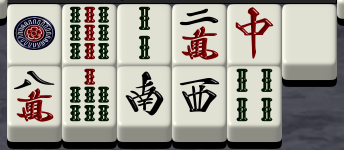
Example 2:
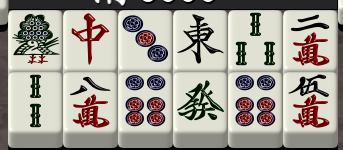
In example 1, the patterns that should stand out are 
 and
and 

 . The
. The  could be a Senki-suji, followed by a
could be a Senki-suji, followed by a  Ura-suji, suggesting a dangerous
Ura-suji, suggesting a dangerous 
 wait. Also, the
wait. Also, the 
 could both be Ura-suji, forming an Aida Yon Ken around
could both be Ura-suji, forming an Aida Yon Ken around 
 . The Matagi-suji
. The Matagi-suji  further suggests this wait is dangerous.
further suggests this wait is dangerous.
In example 2, the dangerous patterns are 
 and
and 

 . The
. The  could be a Senki-suji combined with a
could be a Senki-suji combined with a  Matagi-suji for a
Matagi-suji for a 
 wait. Also, the
wait. Also, the  could be a Senki-suji combined with a
could be a Senki-suji combined with a  Ura-suji and
Ura-suji and  Matagi-suji for a
Matagi-suji for a 
 wait.
wait.
Answer 1:













Answer 2:













As you can see, Suji theories aren't an exact science. They will often indicate several dangerous waits rather than just one. Also, there are plenty of cases where opponents won't use Ryanmen waits or where they will make inefficient moves on purpose just to throw you off. Ultimately you must be prepared to adapt to different situations and different opponents -- but it never hurts to have some theory by your side.
